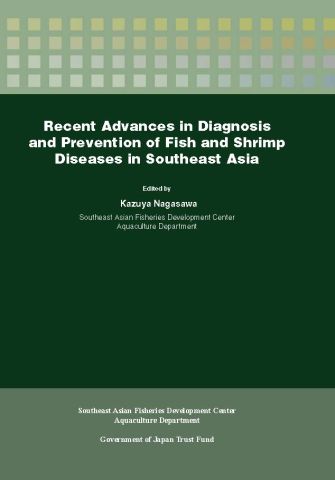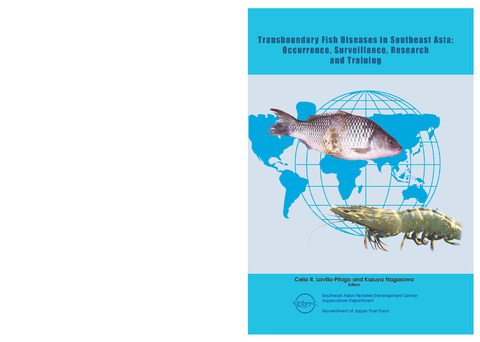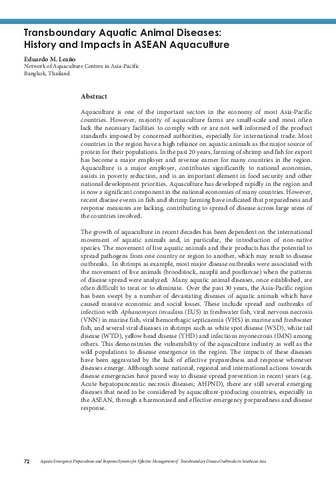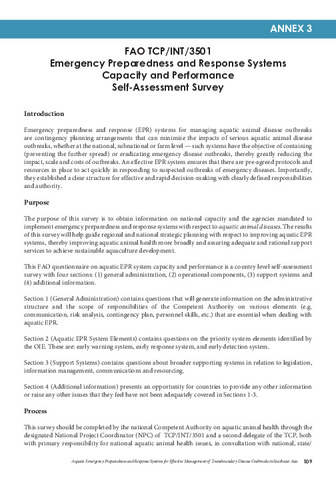Recent advances in diagnosis and prevention of fish and shrimp diseases in Southeast Asia: Terminal report of the regional fish disease project on development of fish disease inspection methodologies for artificially-bred seeds funded by the Government of Japan Trust Fund from 2000 to 2004
- Global styles
- MLA
- Vancouver
- Elsevier - Harvard
- APA
- Help
Share
記述
Fish diseases are one of the major constraints and threats to aquaculture production in Southeast Asia. Numerous infectious diseases have been reported from fish and shrimp cultured in this region. Currently, several emerging diseases are also recognized in the region. These diseases cause large-scale mass mortalities of cultured species, inducing devastating losses to the regional aquaculture production.
Various chemicals including antibiotics, pesticides, disinfectants and others are often used to control fish diseases in the region. There is, however, a need to ensure that aquaculture products are safe for humans, and the presence of chemical residues in aquaculture products have made a serious, negative impact on international trade in exporting countries.
The Aquaculture Department of the Southeast Asian Fisheries Development Center (SEAFDEC) based in Tigbauan, Iloilo, Philippines, has conducted the Regional Fish Disease Project to address fish disease problems and food safety issues in the region with funding from the Government of Japan (GOJ) Trust Fund. Under the title of “Development of Fish Disease Inspection Methodologies for Artificially-Bred Seeds,” the first phase of the project was implemented for five years from 2000 to 2004. During this period, many activities including research, hands-on training, international meetings and extension were conducted.
This volume entitled “Recent Advances in Diagnosis and Prevention of Fish and Shrimp Diseases in Southeast Asia” is a terminal report of the Regional Fish Disease Project on “Development of Fish Disease Inspection Methodologies for Artificially-Bred Seeds” funded by the GOJ Trust Fund. This is a compilation of the outcome of various activities conducted from 2000 to 2004. In addition to this report, a number of scientific papers, manuals, proceedings of international meetings and others have been published to disseminate the outputs of the project (see Chapter 4).
Suggested Citation
Nagasawa, K. (Ed.). (2005). Recent advances in diagnosis and prevention of fish and shrimp diseases in Southeast Asia: Terminal report of the regional fish disease project on development of fish disease inspection methodologies for artificially-bred seeds funded by the Government of Japan Trust Fund from 2000 to 2004. Tigbauan, Iloilo, Philippines: Aquaculture Department, Southeast Asian Fisheries Development Center.
Type
BookISBN
9718511732Format
ix, 484 pages ; 30 cm.
Showing items related by title, author, creator and subject.
-
Transboundary fish diseases in Southeast Asia: Occurrence, surveillance, research and training
Lavilla-Pitogo, Celia R.; Nagasawa, Kazuya (Aquaculture Department, Southeast Asian Fisheries Development Center, 2004)The meeting aims to share and collect the most current information on the occurrence of transboundary fish diseases and surveillance, quarantine, diagnosis, monitoring, research and training for aquatic animal diseases in ... -
Transboundary aquatic animal diseases: History and impacts in ASEAN aquaculture
Leaño, Eduardo M. (Aquaculture Department, Southeast Asian Fisheries Development Center, 2019)Aquaculture is one of the important sectors in the economy of most Asia-Pacific countries. However, majority of aquaculture farms are small-scale and most often lack the necessary facilities to comply with or are not well ... -
FAO TCP/INT/3501: Emergency preparedness and response systems capacity and performance self-assessment survey
Tendencia, Eleonor A.; de la Peña, Leobert D.; de la Cruz, Joesyl Marie V.; FAO (Aquaculture Department, Southeast Asian Fisheries Development Center, 2019)The purpose of this survey is to obtain information on national capacity and the agencies mandated to implement emergency preparedness and response systems with respect to aquatic animal diseases. The results of this survey ...





